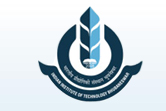 |
 Admission into Ph.D. Programme : 2023-24 (Under Visvesvaraya PhD scheme for Electronics and IT: Phase-II Round-II 2023) |
Applications are invited for admission to the Ph.D. Programme under the Visvesvaraya Ph.D. fellowship scheme for Electronics and IT, Phase II of the Institute in specific areas of electronics (Electronic System Design and Manufacturing i.e., ESDM) and IT (IT/IT Enabled Services i.e., IT/ITES).
Candidates should carefully read the eligibility criteria before applying for the programme. Since all the applications will be screened/shortlisted based on the data submitted by the candidates in the "online application form", the candidates must satisfy themselves of the suitability for the programme to which they are applying. If at any stage, if it is found that candidates have furnished false or wrong data/information, their candidature/admission will be rejected/cancelled.
Application once submitted successfully cannot be altered/resubmitted under any circumstances. Further, no request with respect to making changes in any data/particulars entered by the candidate in the Online Application will be entertained. Therefore, please keep all data/information ready before you start filling up the Application Online. Please note that a candidate should submit only one application. Duplicate applications will be summarily rejected.
| Opening date for online application | : | 11th September, 2023 |
| Last date for submission of online application | : | 5th October, 2023 |
Thrust Areas:
| Electronic System Design and Manufacturing | Semiconductor device design and fabrication, Sensors and biomimetic devices, Semiconducting and nanostructured materials, System-on- chip design, Analog and digital CMOS IC design, RF and mixed signal IC design, Electric Vehicle Subsystems, Power Management Circuits, Power Semiconductor Devices, 3D-NAND Flash Memory, Semiconductor Device Modeling and Simulation, Emerging Nanoscale Devices, advanced communication systems and wireless communications, Thermal management of electronics, RF and Microwave Circuits, VLSI Architecture Design, Reconfigurable Computing, AI Hardware accelerators. | IT/IT Enabled Services | Artificial Intelligence, Machine Learning, Natural Language Processing, Internet-of-Things, Cyber-Physical Systems, Multi-Robot Systems, Distributed Systems, Algorithms, Computer Vision, Visual Surveillance, Intelligent Transportation Systems, Software Defined Networks, Cryptography and Network Security, Formal Methods for Testing and Verification, Languages, Compilers, High Performance Computing Architecture, Systems for extended reality, Low-power embedded and high-performance computing systems, Generalizable and scalable specialization for domain-specific systems, TinyML, Edge Computing, Speech and audio signal processing. |
(Engineering discipline: Electrical Engineering, Computer Science and Engineering, Electronics and Communication Engineering, Mechanical Engineering)
| Eligibility Criteria |
Minimum qualifying degree required for seeking admission to the Ph.D. programOR B. Tech (Bachelor of Technology)/ BE (Bachelor of Engineering)/ B.Sc (Engg.) |
GATE / NET Disciplines for PhD admission
|
Electrical Engineering |
1. Electrical Engineering (EE) | 1. Electronic Science (Code-88) |
| 2. Instrumentation (IN) | ||
| Computer Science and Engineering | 1.Computer Science and Information Technology (CS) | 1. Computer Science and Applications (Code-87) |
| Electronics and Communication Engineering | 1.Electronics and Communication Engineering (EC) | 1. Electronic Science (Code-88) |
| 2. Instrumentation Engineering (IN) | ||
| 3. Electrical Engineering (EE) | ||
| Mechanical Engineering | 4. Mechanical Engineering (ME) |
Only the candidates enrolled/registered for Ph.D. under this scheme would be eligible to apply for financial support. They must meet the minimum academic qualification as applicable under this category. Details are given available in Information Brochure for Ph.D. Admission under Visvesvaraya Fellowship Scheme 2023-24.
| For General, General (EWS) and OBC Candidates | : | Rs. 500/- (Rupees Five Hundred Only) |
| For SC/ST/PwD Candidates | : | Rs. 250/- (Rupees Two Hundred Fifty Only) |
- Application Fee (Non- refundable): USD 50 for all category (Foreign Nationals).
- Application fee once paid shall not be refunded under any circumstances.
- Female candidates are exempted from payment of application fee.